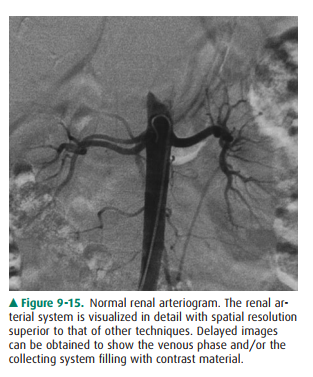Chapter: Basic Radiology : Radiology of the Urinary Tract
Angiography - Radiology of the Urinary Tract: Techniques and Normal Anatomy
Angiography
The role of angiography as a
diagnostic tool continues to di-minish with the increasing accuracy of
noninvasive tech-niques to evaluate the vascular system. The renal arteriogram
is performed after puncture of a more peripheral vessel such as the common
femoral artery, with advancement of a catheter into the renal artery origin.
Contrast material is in-jected via the catheter and rapid, typically digital,
conventional radiographic images are obtained. The renal arterial vessels are
well demonstrated, along with nephrographic images of the kidney and views of
the venous drainage (Figure 9-15). Delayed images may be obtained to
demonstrate the renal col-lecting system. The angiogram plays little role in
diagnostic evaluation of the renal parenchyma, having been supplanted by
cross-sectional imaging techniques. However, the still supe-rior spatial
resolution of angiography permits detailed evalua-tion of the renal arterial
supply and has a small but important diagnostic role in evaluating the small
vessels of the kidney for such diseases as vasculitis and fibromuscular
dysplasia. Themain role for angiography today, as discussed later, is aiding
and guiding interventional, therapeutic techniques.

Related Topics